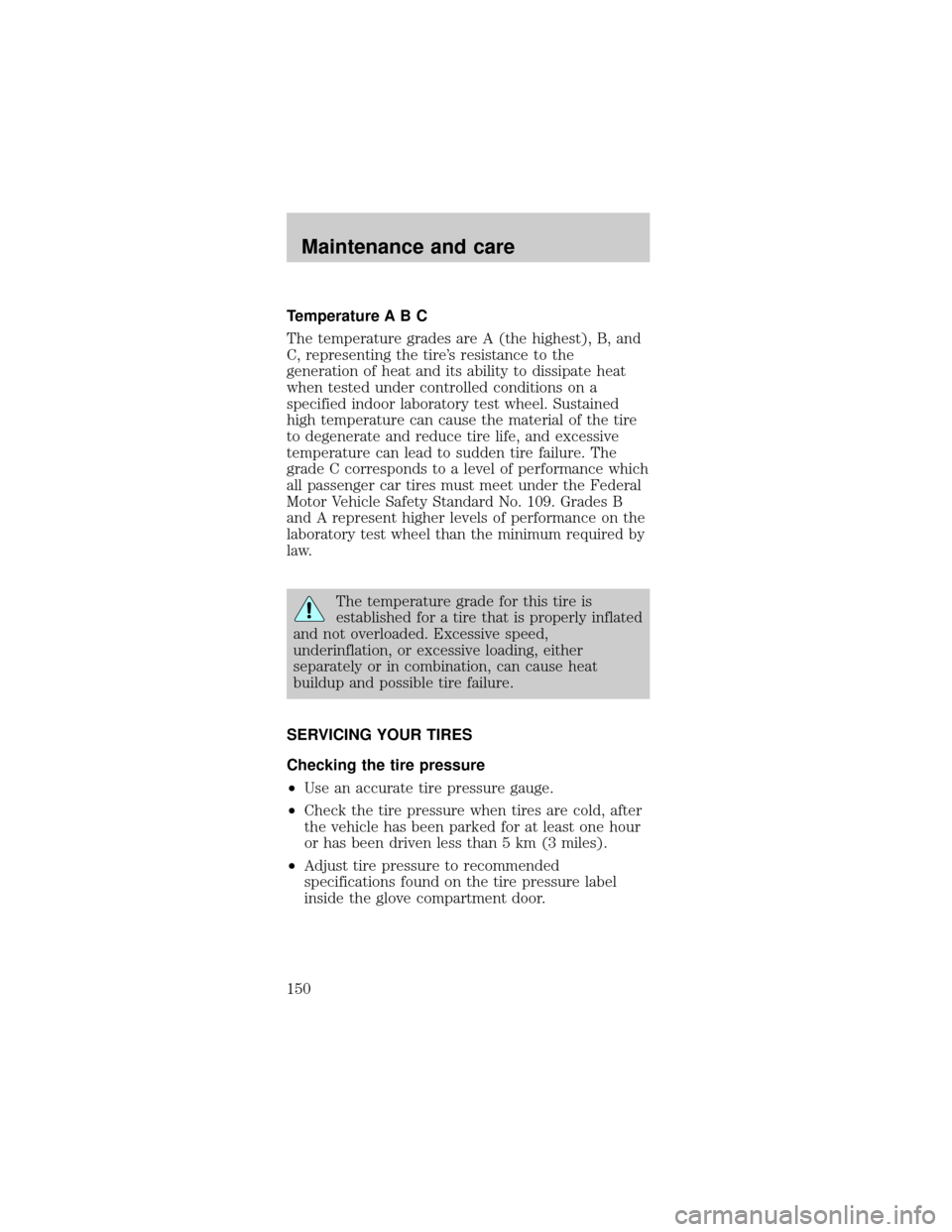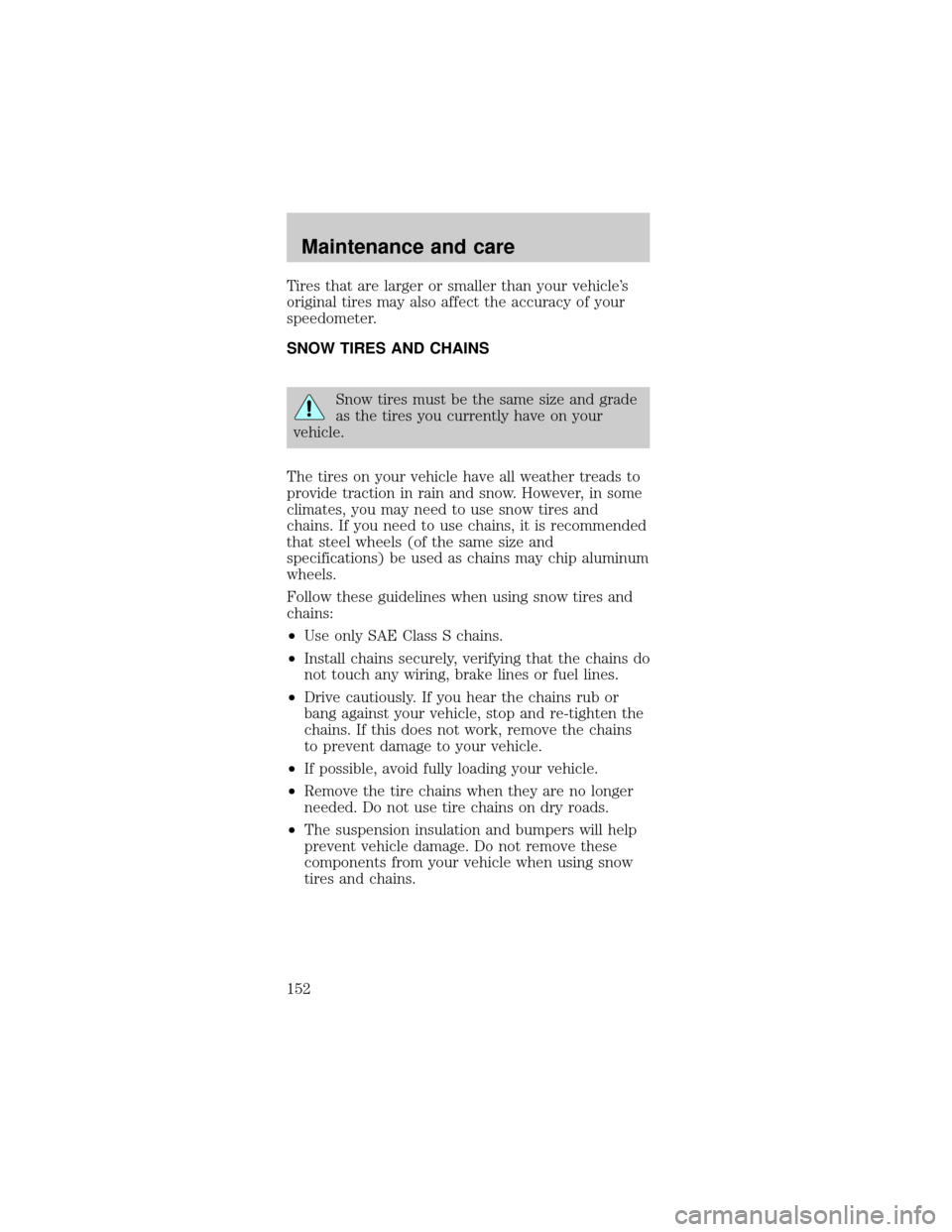wheel Mercury Sable 1998 s Owner's Guide
[x] Cancel search | Manufacturer: MERCURY, Model Year: 1998, Model line: Sable, Model: Mercury Sable 1998Pages: 190, PDF Size: 1.29 MB
Page 150 of 190

Temperature A B C
The temperature grades are A (the highest), B, and
C, representing the tire's resistance to the
generation of heat and its ability to dissipate heat
when tested under controlled conditions on a
specified indoor laboratory test wheel. Sustained
high temperature can cause the material of the tire
to degenerate and reduce tire life, and excessive
temperature can lead to sudden tire failure. The
grade C corresponds to a level of performance which
all passenger car tires must meet under the Federal
Motor Vehicle Safety Standard No. 109. Grades B
and A represent higher levels of performance on the
laboratory test wheel than the minimum required by
law.
The temperature grade for this tire is
established for a tire that is properly inflated
and not overloaded. Excessive speed,
underinflation, or excessive loading, either
separately or in combination, can cause heat
buildup and possible tire failure.
SERVICING YOUR TIRES
Checking the tire pressure
²Use an accurate tire pressure gauge.
²Check the tire pressure when tires are cold, after
the vehicle has been parked for at least one hour
or has been driven less than 5 km (3 miles).
²Adjust tire pressure to recommended
specifications found on the tire pressure label
inside the glove compartment door.
Maintenance and care
150
Page 152 of 190

Tires that are larger or smaller than your vehicle's
original tires may also affect the accuracy of your
speedometer.
SNOW TIRES AND CHAINS
Snow tires must be the same size and grade
as the tires you currently have on your
vehicle.
The tires on your vehicle have all weather treads to
provide traction in rain and snow. However, in some
climates, you may need to use snow tires and
chains. If you need to use chains, it is recommended
that steel wheels (of the same size and
specifications) be used as chains may chip aluminum
wheels.
Follow these guidelines when using snow tires and
chains:
²Use only SAE Class S chains.
²Install chains securely, verifying that the chains do
not touch any wiring, brake lines or fuel lines.
²Drive cautiously. If you hear the chains rub or
bang against your vehicle, stop and re-tighten the
chains. If this does not work, remove the chains
to prevent damage to your vehicle.
²If possible, avoid fully loading your vehicle.
²Remove the tire chains when they are no longer
needed. Do not use tire chains on dry roads.
²The suspension insulation and bumpers will help
prevent vehicle damage. Do not remove these
components from your vehicle when using snow
tires and chains.
Maintenance and care
152
Page 168 of 190

Waxing your vehicle
Wax when water stops beading on the surface. This
could be every three or four months, depending on
operating conditions.
Use only carnauba or synthetic-based waxes. Use
cleaning fluid or alcohol with a clean cloth to remove
any bugs and tar before waxing vehicle. Use tar
remover to remove any tar spots.
Avoid getting wax on the windshield. If you have
wax applied at a commercial car wash, it is
recommended that you clean the wiper blades and
windshield as described inCleaning the wiper
blades and windshield.
Repairing paint chips
Minor scratches or paint damage from road debris
may be repaired with touch-up paint, repair foil or
aerosol paint spray from the Ford accessory line.
Observe the application instructions on the
products.
Remove particles such as bird droppings, tree sap,
insect remains, tar spots, road salt and industrial
fallout immediately.
Cleaning the wheels
Wash with the same detergent as the body of your
vehicle. Do not use acid-based or alcohol-based
wheel cleaners, steel wool, fuel or strong detergents.
Never use abrasives that will damage the finish of
special wheel surfaces. Use a tar remover to remove
grease and tar.
Cleaning the engine
Engines are more efficient when they are clean
because grease and dirt buildup keep the engine
warmer than normal. When washing:
²Take care when using a power washer to clean
the engine. The high pressure fluid could
penetrate the sealed parts and cause damage.
Maintenance and care
168
Page 177 of 190

ENGINE DATA
Engine 3.0L V6 Vulcan
engine3.0L V6
Duratec
engine
Cubic inches 182 181
Horsepower 145 @ 5250
rpm200 @ 5750
rpm
Torque 170 lb.-ft. @
3250 rpm200 lb.-ft. @
4500 rpm
Recommended
fuel87 octane 87 octane
Firing order 1-4-2-5-3-6 1-4-2-5-3-6
Spark plug gap 1.07-1.17 mm
(0.042-0.046
inch)1.3-1.4 mm
(0.052-00.056
inch)
Ignition system EDIS EDIS
Compression
ratio9.3:1 10:1
VEHICLE DIMENSIONS
Vehicle
dimensionsSedan mm
(in)Wagon mm (in)
(1) Overall
length5 016.5
(197.5)5 069.8 (199.6)
(2) Overall
width1 854.2 (73.0) 1 854.2 (73.0)
(3) Overall
height1 399.5 (55.1) 1 463.0 (57.6)
(4) Wheelbase 2 755.9
(108.5)2 755.9 (108.5)
(5) Track -
Front1 564.6 (61.6) 1 564.6 (61.6)
(5) Track -
Rear1 559.6 (61.4) 1 569.7 (61.8)
Capacities and specifications
177
Page 182 of 190

Air bag supplemental
restraint system ........ 66
and child
safety seats ............. 69
description .............. 67
disposal .................... 72
indicator light ......... 72
passenger air bag ... 70
Air conditioning
automatic temperature
control
system . 21,22,23,24,26
Anti-theft system ...... 47
arming the system .. 47
Automatic transaxle . 93
driving
with ........... 96,97,98,99
Brakes ........................ 89
anti-lock ................... 89
anti-lock brake system
(ABS) warning
light .......................... 90
fluid, checking and
adding .................... 133
shift interlock .......... 93
Break-in period ........... 3
Cargo cover .......... 41,42
Cargo net ................... 41
Cellular telephone
(see your Cellular
Phone Guide) ............ 39
Child safety seats
attaching with tether
straps ....................... 78
in rear seat ......... 76,78
tether anchorage
hardware ................. 79
Cleaning your
vehicle ...................... 167
built-in child
seat ..................... 80,83engine
compartment ......... 168
exterior lamps ....... 170
plastic parts .......... 170
washing .................. 167
waxing ................... 168
wheels .................... 168
wiper blades .......... 170
Console ...................... 38
Controls
power seat ............... 55
Coolant ............. 137,138
checking and
adding .................... 135
refill capacities ...... 137
Defrost
rear window ............ 17
Doors
central unlocking 36,37
Emission control
system ...................... 158
Engine
coolant ................... 134
idle speed control . 142
service points . 129,130
starting after a
collision ................. 108
Engine block heater . 87
Engine oil
checking and
adding .................... 132
dipstick .................. 130
specifications . 130,132
Exhaust fumes .......... 87
Floor mats ................. 39
Fuel
choosing the
right fuel ................ 156
detergent in fuel ... 157
filling your vehicle
with fuel ......... 153,155
quality .................... 156
Index
182
Page 184 of 190

Parking brake ............ 91
Power distribution box
(see Fuses) ............. 112
Power door locks ...... 36
Power steering .......... 92
fluid, checking and
adding ............. 138,139
Relays ............... 109,115
Remote entry system 43
illuminated entry .... 45
locking/unlocking
doors ................... 43,44
replacement/additional
transmitters ............. 45
replacing the
batteries .................. 46
Safety restraints ........ 62
cleaning the safety
belts .................. 66,172
extension
assembly .................. 64
for children ........ 72,73
lap belt ............... 61,62
warning light and
chime .................. 11,65
Seat belts (see Safety
restraints) ... 57,58,59,60
Seats .......................... 54
child safety seats .... 74
cleaning .......... 171,172
Servicing your
vehicle ...................... 127
Spark plugs,
specifications ........... 173
Specification chart,
lubricants ................. 175
Speed control ............ 28
Speedometer ............. 12
Starting your
vehicle .............. 84,85,86jump
starting .... 121,122,124
Steering wheel
tilting ....................... 33
Tires .................. 148,150
changing ................ 118
checking the
pressure ................. 150
replacing ................ 151
rotating .................. 151
snow tires an
d chains ................. 152
treadwear .............. 149
Towing
wrecker .................. 126
Transaxle
fluid, refill
capacities ............... 174
Transmission ........... 140
fluid, checking and
adding
(automatic) .... 140,141
Trip odometer ........... 14
Trunk
remote releas
e lever ...................... 40
Vehicle dimensions . 177
Vehicle Identification
Number (VIN) ......... 180
Vehicle loading ........ 100
Ventilating your
vehicle ........................ 88
Warning chimes ........... 6
Washer fluid ............ 134
Wheels
anti-theft lug
nuts ................. 117,118
Windows ............... 35,36
rear wiper/washer ... 32
Index
184